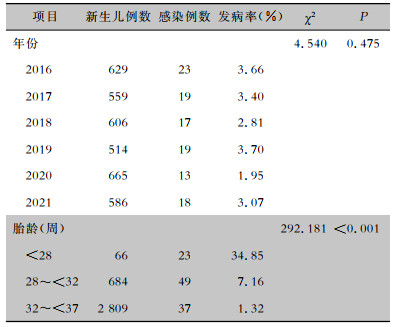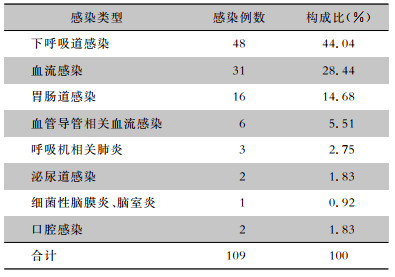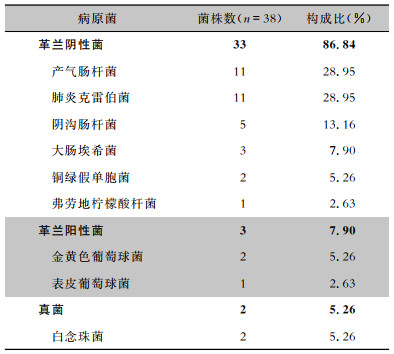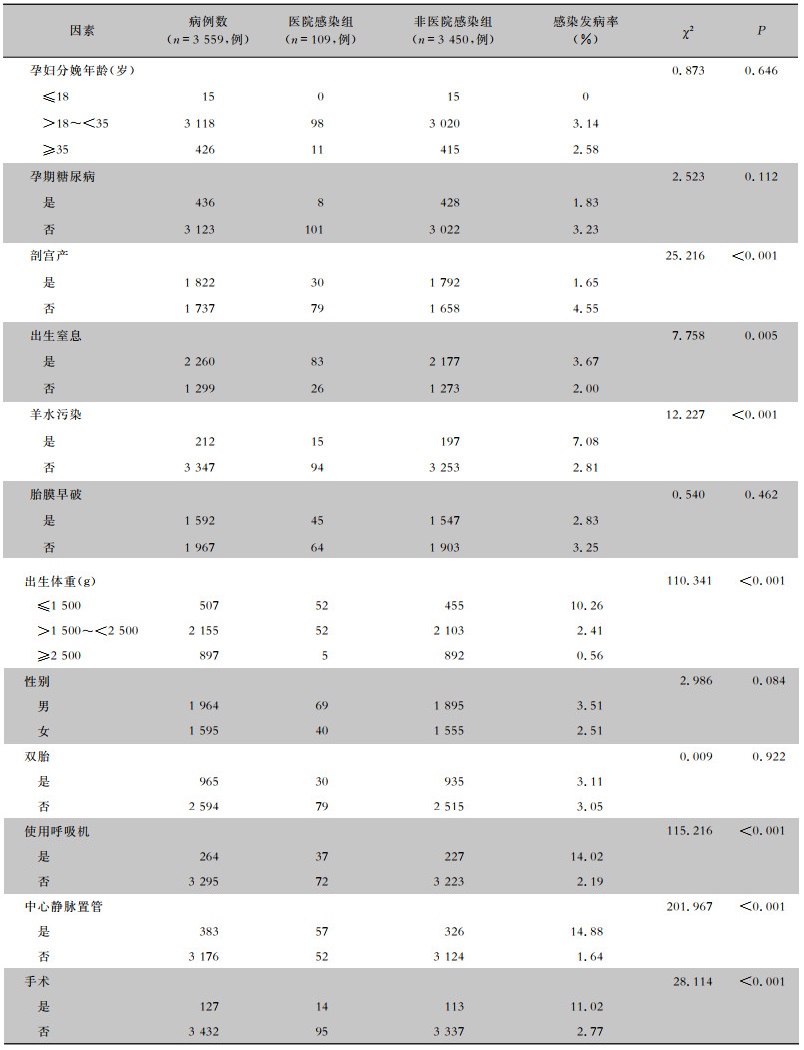2. 南通大学附属妇幼保健院群体保健科, 江苏 南通 226000
2. Department of Population Health Care, Affiliated Maternity and Child Health Care Hospital of Nantong University, Nantong 226000, China
医院感染(healthcare-associated infection)是指患者在住院期间发生的感染以及在医院内获得出院后发生的感染,但不包括入院前已开始或者入院时已处于潜伏期的感染[1]。医院感染是一个严重的公共卫生问题,导致住院时间延长,增加住院费用及死亡风险[2]。早产儿又称未成熟儿,是指胎龄<37周的活产新生儿,由于机体发育不成熟、基础疾病严重、免疫功能低、从胎盘中获得的抗体少、血IgG水平低等原因,较其他年龄组人群更容易发生医院感染[3]。现有研究[4-6]表明,我国早产儿医院感染发病率为4.97%~11.19%,高于足月新生儿[7-11]。因此,降低早产儿医院感染发病率具有重要意义。本研究选取2016年1月—2021年12月南通大学附属妇幼保健院新生儿病房收治的早产儿作为研究对象,旨在探究早产儿医院感染特点及影响因素,为医院感染防控提供理论和实践依据。
1 对象与方法 1.1 研究对象2016年1月1日—2021年12月31日南通大学附属妇幼保健院新生儿病房的住院早产儿。纳入标准:住院时间>48 h且胎龄<37周的新生儿。排除标准:入院时已经存在感染的新生儿;存在宫内感染的新生儿;临床资料不完整的新生儿。本研究经该院伦理委员会审核批准(Y2022030号)。
1.2 诊断标准按照国家卫生部颁布的《医院感染诊断标准(试行)》[1]执行,呼吸机相关肺炎(VAP)[12]、导管相关血流感染(CLABSI)[13]参照我国相关指南诊断。
1.3 资料收集采用回顾性调查方法,逐一查阅电子病历,收集早产儿基本信息及住院期间诊疗信息,包括出生体重、性别、胎龄、分娩方式、是否双胎、是否羊水污染、母亲妊娠期有无糖尿病、有无胎膜早破、使用呼吸机、经脐或中心静脉置管、医院感染等。
1.4 统计分析应用SPSS 26.0软件进行统计分析,计数资料采用χ2检验;采用非条件多因素logistic回归进行多因素分析,P≤0.05表示差异有统计学意义。
2 结果 2.1 基本情况2016年1月1日—2021年12月31日南通大学附属妇幼保健院新生儿病房共有住院新生儿9 301例。符合纳入标准新生儿3 738例,根据研究标准排除新生儿179例,其中宫内感染新生儿93例,入院时存在感染新生儿30例,临床资料不完整新生儿56例。最终纳入早产儿3 559例,其中男1 964例,女1 595例;出生体重202~5 430 g,平均出生体重(2 108.66±631.17)g。
2.2 医院感染情况及趋势3 559例住院新生儿总住院日数57 963 d,发生医院感染109例,医院感染发病率3.06%,医院感染日发病率1.88‰。不同年份早产儿医院感染发病率比较,差异无统计学意义(P>0.05);不同胎龄早产儿医院感染发病率比较,差异有统计学意义(P<0.05)。见表 1。
| 表 1 不同年份、胎龄早产儿医院感染发病情况 Table 1 Occurrence of HAI in premature infants in different years and different gestational ages |

|
109例早产儿主要感染类型分别为下呼吸道感染(44.04%)、血流感染(28.44%)、胃肠道感染(14.68%),共占87.16%。见表 2。
| 表 2 早产儿医院感染类型分布 Table 2 Distribution of HAI types in premature infants |

|
共检出医院感染病原菌38株,其中革兰阴性菌33株(86.84%)。主要感染病原菌为产气肠杆菌(28.95%)、肺炎克雷伯菌(28.95%)。见表 3。
| 表 3 早产儿医院感染病原菌分布 Table 3 Distribution of HAI pathogens in premature infants |

|
以是否发生医院感染为因变量,一般人口学特征及住院期间诊疗信息为自变量进行单因素分析,结果显示,在剖宫产、出生窒息、羊水污染、低出生体重、使用呼吸机、中心静脉置管、手术方面比较,差异均有统计学意义(均P<0.05)。见表 4。
| 表 4 早产儿医院感染影响因素单因素分析 Table 4 Univariate analysis on HAI in premature infants |

|
以是否发生医院感染为因变量,以单因素分析中有统计学意义的变量为自变量,进行二元logistic回归分析,结果显示羊水污染、出生体重<2 500 g、使用呼吸机、中心静脉插管是早产儿医院感染的独立危险因素(均P<0.05);剖宫产是早产儿医院感染的保护因素(P<0.05)。见表 5。
| 表 5 早产儿医院感染危险因素logistic多因素分析 Table 5 Multivariate logistic analysis on HAI in premature infants |

|
2016—2021年南通大学附属妇幼保健院早产儿医院感染发病率3.06%,低于国内其他研究报道的早产儿医院感染发病率[4-7],高于研究[8-11, 14]报道的新生儿医院感染发病率。该医疗机构早产儿医院感染发病率相对较低的原因,可能与该机构针对早产儿群体采取了包括集中分室收治、开展目标性监测、母乳喂养、诊疗用品一次性使用、每季度环境终末消毒等一系列感染防控措施有关。研究[15]表明,开展目标性监测有助于早期发现危险因素并采取干预措施,能够降低感染发病率。而母乳中含有多种抗菌因子及活性物质,母乳喂养可以降低医院感染风险[16-17]。临床实践中,诊疗用品一次性使用可以降低因复洗、消毒不到位造成的感染风险。因此积极采取感染防控措施是该医疗机构早产儿医院感染发病率较低的原因。
下呼吸道、血液、胃肠道是本次研究中早产儿的主要感染部位,与国内学者报道[4-7]一致。产气肠杆菌是最常见的感染病原菌,该细菌存在于水、土壤等环境中,同时也是肠道正常微生物[18],此次研究中主要感染部位为下呼吸道及血液系统,提示需要做好内源性细菌引起的感染防控,未来应采取的防控措施包括:①合理使用抗菌药物;②最大限度促进母乳喂养;③加强手卫生及环境消毒。
早产儿往往伴随低体重等现象,研究[16]显示低出生体重儿的免疫功能尚未发育成熟,且需要特殊的诊疗方式,在此期间特别容易受到细菌感染。本研究也发现出生体重≤1 500 g、>1 500~<2 500 g的早产儿其医院感染风险是≥2 500 g早产儿的3.8倍(P<0.05),与研究[5-6, 9-10]结论相同。此外使用呼吸机、中心静脉置管、羊水污染均为早产儿医院感染的独立危险因素,这与部分研究[5-6, 10, 19]结论一致。呼吸机、中心静脉置管是新生儿病房常规侵入性诊疗手段,但会破坏皮肤、黏膜完整性,且器械管路将外界与体内环境相通,环境病原体可能进入机体导致感染。穿刺操作不规范、器械维护不到位、口腔护理不当等也会增加感染机会[6]。羊水直接与新生儿皮肤、口腔接触,分娩时污染的羊水刺激可能导致皮肤感染、吸入性肺炎。
本研究还发现,剖宫产是早产儿医院感染的保护性因素(OR=0.362,P<0.05),研究[20]认为阴道分娩会导致早发型败血症的风险增加。人体正常的阴道内定植有大量的微生物以维持生态平衡,但这种生态平衡受多种因素影响,如胎膜早破会导致阴道内环境由弱酸性变为弱碱性,引起微生态失调[21],新细菌定植也可破坏阴道内环境[22],增加阴道分娩新生儿感染风险。但也有研究[17]认为阴道分娩新生儿IgG水平高于剖宫产儿,且剖宫产会导致新生儿肝脏合成功能受损,容易发生感染。笔者结合临床实践认为,阴道分娩时的产程长短、产房环境及器械消毒情况、会阴侧切情况、放置球囊情况等,均可增加感染机会。
综上所述,早产儿医院感染风险高,影响因素多,临床应引起重视,积极采取有循证依据的防控措施,以减少危险因素暴露,保护早产儿健康。本研究为回顾性研究,部分临床资料缺失无法收集,可能对结果产生一定影响,后续可开展队列研究进一步探讨;此外未对产气肠杆菌来源、传播途径进行深入分析,后续可采集环境、新生儿微生物检测标本,进行宏基因测序。
利益冲突:所有作者均声明不存在利益冲突。
| [1] |
中华人民共和国卫生部. 关于印发医院感染诊断标准(试行)的通知[EB/OL]. (2001-11-07)[2023-06-10]. http://www.nhc.gov.cn/wjw/gfxwj/201304/37cad8d95582456d8907ad04a5f3bd4c.shtml. Ministry of Health of the PRC. Notice on issuing hospital infection diagnosis standards (trial)[EB/OL]. (2001-11-07)[2023-06-10]. http://www.nhc.gov.cn/wjw/gfxwj/201304/37cad8d95582456d8907ad04a5f3bd4c.shtml. |
| [2] |
Del Moral T. Nosocomial infections in premature infants, where are we going?[J]. An Pediatr (Engl Ed), 2019, 91(1): 1-2. |
| [3] |
Collins A, Weitkamp JH, Wynn JL. Why are preterm newborns at increased risk of infection?[J]. Arch Dis Child Fetal Neonatal Ed, 2018, 103(4): F391-F394. DOI:10.1136/archdischild-2017-313595 |
| [4] |
翁月萍, 陈夏容, 张华平, 等. 早产儿医院感染调查分析与防控策略[J]. 医学理论与实践, 2022, 35(15): 2664-2666. Weng YP, Chen XR, Zhang HP, et al. The investigation, analysis and control strategies of nosocomial infection in premature infants[J]. The Journal of Medical Theory and Practice, 2022, 35(15): 2664-2666. |
| [5] |
罗盛鸿, 严素芬. 早产儿医院感染危险因素研究[J]. 中国感染控制杂志, 2016, 15(6): 405-407, 411. Luo SH, Yan SF. Risk factors for healthcare-associated infection in premature infants[J]. Chinese Journal of Infection Control, 2016, 15(6): 405-407, 411. DOI:10.3969/j.issn.1671-9638.2016.06.010 |
| [6] |
章旭平. 重症监护室早产儿医院感染发生情况及危险因素分析[J]. 江西医药, 2019, 54(11): 1414-1416, 1422. Zhang XP. Analysis of the incidence and risk factors of hospital infection in premature infants in intensive care units[J]. Jiangxi Medical Journal, 2019, 54(11): 1414-1416, 1422. DOI:10.3969/j.issn.1006-2238.2019.11.037 |
| [7] |
刘菊敏, 鲁芹, 亓立红, 等. 早产儿医院感染病原菌分布与耐药性分析[J]. 中华医院感染学杂志, 2015, 25(10): 2351-2353. Liu JM, Lu Q, Qi LH, et al. Distribution and drug resistance of pathogens causing nosocomial infections in premature infants[J]. Chinese Journal of Nosocomiology, 2015, 25(10): 2351-2353. |
| [8] |
贾会学, 殷环, 吴安华, 等. 新生儿重症监护病房医院感染流行病学多中心研究[J]. 中国感染控制杂志, 2015, 14(10): 649-653. Jia HX, Yin H, Wu AH, et al. Multicenter study on epidemio-logy of healthcare-associated infection in neonatal intensive care units[J]. Chinese Journal of Infection Control, 2015, 14(10): 649-653. DOI:10.3969/j.issn.1671-9638.2015.10.001 |
| [9] |
蒋琳, 李欣妍, 廖祯, 等. NICU新生儿医院感染临床特点及危险因素[J]. 中华医院感染学杂志, 2023, 33(1): 125-128. Jiang L, Li XY, Liao Z, et al. Clinical characteristics and risk factors for nosocomial infection in neonates of NICU[J]. Chinese Journal of Nosocomiology, 2023, 33(1): 125-128. |
| [10] |
施玉珍, 黄珊红, 程少彬. NICU新生儿医院感染危险因素分析及护理防控对策[J]. 中国卫生标准管理, 2022, 13(15): 174-178. Shi YZ, Huang SH, Cheng SB. Analysis of risk factors of nosocomial infection of neonates in NICU[J]. China Health Standard Management, 2022, 13(15): 174-178. |
| [11] |
黄梅香, 周春浪, 谭伟, 等. 新生儿医院感染临床和病原学特点及影响因素的分析[J]. 中国优生与遗传杂志, 2021, 29(2): 198-201. Huang MX, Zhou CL, Tan W, et al. Analysis of clinical and pathogenic characteristics and influencing factors of neonatal nosocomial infection[J]. Chinese Journal of Birth Health & Heredity, 2021, 29(2): 198-201. |
| [12] |
中华医学会呼吸病学分会感染学组. 中国成人医院获得性肺炎与呼吸机相关性肺炎诊断和治疗指南(2018年版)[J]. 中华结核和呼吸杂志, 2018, 41(4): 255-280. Infectious Disease Group of the Respiratory Disease Branch of the Chinese Medical Association. Chinese adult hospital acquired pneumonia and ventilator associated pneumonia diagnosis and treatment guidelines(2018)[J]. Chinese Journal of Tuberculosis and Respiratory Disease, 2018, 41(4): 255-280. |
| [13] |
中华人民共和国国家卫生健康委办公厅. 血管导管相关感染预防与控制指南(2021版)[J]. 中国感染控制杂志, 2021, 20(4): 387-388. General Office of the National Health Commission of the People's Republic of China. Guidelines for the prevention and control of vessel catheter associated infection (2021 edition)[J]. Chinese Journal of Infection Control, 2021, 20(4): 387-388. |
| [14] |
王舜钦, 吴停停, 张敏, 等. 新生儿医院感染特点与相关因素的分类树分析[J]. 中华医院感染学杂志, 2019, 29(8): 1209-1213. Wang SQ, Wu TT, Zhang M, et al. Characteristics and classification tree analysis on related factors of neonatal nosocomial infection[J]. Chinese Journal of Nosocomiology, 2019, 29(8): 1209-1213. |
| [15] |
曹云, 李正红, 韩树萍, 等. 新生儿重症监护室母乳使用专家共识[J]. 中国循证儿科杂志, 2021, 16(3): 171-178. Cao Y, Li ZH, Han SP, et al. Expert consensus on breast milk use in NICU[J]. Chinese Journal of Evidence Based Pedia-trics, 2021, 16(3): 171-178. |
| [16] |
Fleiss N, Tarun S, Polin RA. Infection prevention for extremely low birth weight infants in the NICU[J]. Semin Fetal Neonatal Med, 2022, 27(3): 101345. |
| [17] |
彭寒玲, 张志勤, 张琳娜. 儿童医院新生儿病区医院感染目标性监测[J]. 江苏卫生事业管理, 2023, 34(3): 338-342. Peng HL, Zhang ZQ, Zhang LN. Children's hospital targeted monitoring on healthcare-associated infection in neonates[J]. Jiangsu Health System Management, 2023, 34(3): 338-342. |
| [18] |
周庭银, 章强强. 临床微生物学诊断与图解[M]. 4版. 上海: 上海科学技术出版社, 2017. Zhou TY, Zhang QQ. Diagnosis and illustration of clinical microbiology[M]. 4th ed. Shanghai: Shanghai Scientific & Technical Publishers, 2017. |
| [19] |
刘坤, 孙彦华. 孕产妇围生期感染的高危因素及其与分娩方式、新生儿感染的相关性分析[J]. 中国妇幼保健, 2017, 32(19): 4688-4690. Liu K, Sun YH. Analysis of high-risk factors for perinatal infections in pregnant and postpartum women and their correlation with delivery methods and neonatal infections[J]. Maternal & Child Health Care of China, 2017, 32(19): 4688-4690. |
| [20] |
Teshome G, Hussen R, Abebe M, et al. Factors associated with early onset neonatal sepsis among neonates in public hospitals of Sidama region, Southern Ethiopia, 2021: unmatched case control study[J]. Ann Med Surg (Lond), 2022, 81: 104559. |
| [21] |
裘萧灵, 李惠雯, 徐敏丹. 胎膜早破和妊娠期糖尿病患者阴道菌群分布及对妊娠结局的影响[J]. 中国妇幼保健, 2023, 38(8): 1396-1399. Qiu XL, Li HW, Xu MD. Distribution of vaginal flora in patients with PROMs and gestational diabetes and influence on pregnancy outcome[J]. Maternal and Child Health Care of China, 2023, 38(8): 1396-1399. |
| [22] |
Merello M, Lotte L, Gonfrier S, et al. Enterobacteria vaginal colonization among patients with preterm premature rupture of membranes from 24 to 34 weeks of gestation and neonatal infection risk[J]. J Gynecol Obstet Hum Reprod, 2019, 48(3): 187-191. |



